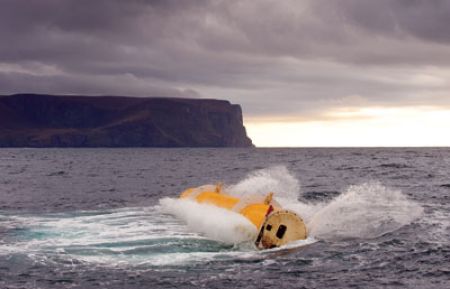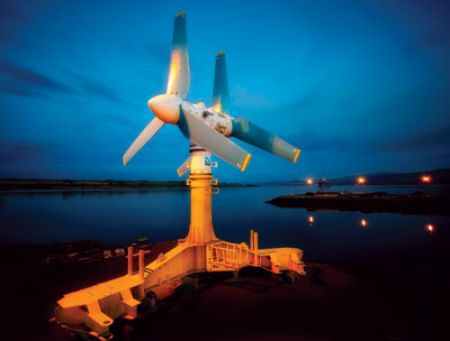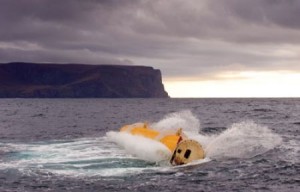Orkney, Scotland — Partnerships between various Scottish organizations and agencies have provided multiple opportunities for developers to advance their technology. One example is Scottish Development International (SDI), the international arm of Scotland’s economic development agency Scottish Enterprise and the Scottish government. SDI was established to encourage investment in the country and to support expansion of Scottish companies overseas. SDI has been actively sourcing technology developers to test devices at EMEC.
Work currently under way at EMEC on two specific technologies illustrates how marine energy technology can contribute to the global electricity mix and the support available for advancing this dynamic sector of the renewable energy industry.
Global Energy Landscape
Over the past 25 years, energy consumption has increased dramatically around the world, to 8,428 million tons of oil equivalent from 4,676 million tons of oil equivalent, according to the International Energy Agency’s (IEA) 2010 Key World Energy Statistics Report. IEA’s report states that developed nations consume on average only slightly less energy from traditional sources like oil, gas, coal, or peat than they did a decade ago, and these sources still provide more than two thirds of the energy consumed in these countries. And yet, even while developed countries are investing heavily in renewable energy development, global CO2 emissions have increased by nearly 30% in the past two decades. Meanwhile, the impact of recent natural and man-made catastrophes on crude oil prices has been felt around the world, with oil prices surging from about US$20 per barrel in 1999 to $80 in 2010 and $116 in early 2011.
Marine Resources in Scotland
Against this backdrop, the importance of identifying new energy solutions has never been greater. Scotland benefits from an estimated 25% of Europe’s tidal energy potential and about 10% of its wave resource. To take advantage of these resources, the Scottish government has focused on bringing together the key ingredients needed to support a thriving marine energy sector, including testing facilities, private-public and university partnerships, and inward investment from global companies. Combined with a well-educated workforce and several port cities that have the potential to serve as hubs of innovation, Scotland is widely seen by marine energy companies around the world as having developed the “perfect blend” to be an international leader in the research and development of new wave and tidal energy technologies.
Scotland has pioneered commercialization of marine energy with the world’s first round of wave and tidal leasing. Six wave and five tidal schemes are to be developed in the Pentland Firth and Orkney waters. These projects range from 50 to 400 MW and, by 2020, could amount to 1.6 GW of marine energy capacity off Scotland’s north coast.
Another key element in the development of this perfect blend has been the creation of the Scottish Energy Laboratory (SEL). SEL will be a “virtual” hub for national and international companies to identify and access the most appropriate of Scotland’s test and demonstration assets for their technologies. This asset network has a combined investment value of about £250 million (US$407.4 million) across wind, hydrogen, and marine energy sectors and includes EMEC in Orkney, the Hydrogen Office in Fife, and the European Offshore Wind Development Centre in Aberdeen.
Testing the Waters
Scotland is attracting the interest of wave and tidal firms from around the world.
EMEC provides testing platforms for a variety of marine energy devices, making the center a highly desired destination for international marine energy innovations. The location of EMEC also provides technology firms with access to protected waters, deeper offshore sites, and a fluctuating climate ideal for pitting their technology against the most rigorous marine conditions.

| The Oyster 1 wave energy converter, developed by Aquamarine Power, has been operating at the European Marine Energy Centre in Scotland since November 2009. The company plans to install a second unit at the testing center in 2011. |
Technology tested at EMEC includes wave and tidal generation devices. Among the diverse marine energy technologies currently undergoing testing at EMEC are Aquamarine Power’s Oyster wave device and Atlantis Resources Corp.’s AK1000 tidal turbine. The evolution of these two technologies in Scotland’s waters represents the best of what EMEC has to offer and demonstrates how it can assist the acceleration of the marine energy industry.
Oyster – building on benchmarks
Scotland’s First Minister Alex Salmond officially launched the Aquamarine Power Oyster 1 at EMEC in November 2009. The Oyster wave power technology converts near-shore waves into clean and sustainable energy through a wave-powered pump attached to the seabed, roughly 10 to 15 meters deep and a half kilometer away from the shore. The movement of the Oyster’s buoyant hinged flap drives two hydraulic pistons to push high-pressure water onshore via a subsea pipeline, where this water drives a conventional hydroelectric turbine.
The benefits and features of the Oyster device lie within its simplistic structure, engineering designed to survive violent weather conditions, and shore-based electricity generation. The Oyster has minimal underwater moving parts; no control system, gearbox, or shutdown mode; and no complex offshore electronics. The hinged flaps are designed to duck under large waves, and the combined near-shore location and robust offshore structure allows the Oyster to operate in and survive storm conditions. The shore-based electricity generation has a minimal impact on marine environments and makes the Oyster device easy to access.
Last year was a major one for Aquamarine Power and EMEC as the Oyster 1 achieved 6,000 hours in operation. Based on the testing benchmarks surpassed at EMEC, Aquamarine Power was able to forge ahead with fabrication of the Oyster 2. This unit is 50% wider than Oyster 1 but is expected to deliver 250% more power. Aquamarine Power attracted an £11 million ($17 million) investment from ABB and existing shareholders for its Oyster technology and is looking forward to installing the second Oyster unit later this year. Aquamarine also announced plans to install two more versions of the device in 2012. Together, these three devices will form a 2.4 MW array connected to a single onshore generating plant.
The partnerships between EMEC and several technology firms, brought together largely by SDI, stand as a perfect example of the multi-faceted support governments can offer to drive this critical sector forward.

| The AK1000 tidal turbine, developed by Atlantis Resources, was installed at the European Marine Energy Centre in late 2010. Despite its large size, including an 18 meter rotor diameter, the unit has minimal effects on the surrounding ecosystem because of its slow rotational speed. |
Putting the AK1000 to work
The AK1000 tidal turbine project is another example of how EMEC can accelerate the development of new technologies. Atlantis Resources, backed by investment firm Morgan Stanley, is a developer of electricity-generating tidal current turbines, with offices in Singapore and the UK. In August 2010, the company unveiled the AK1000, the world’s largest tidal turbine, at Invergordon, Scotland. The next month, the AK1000 was installed in 35 meters of water at an EMEC test site off of Eday in the Orkney Islands. The turbine — which weighs 1,300 tons, is 22.5 meters tall, and boasts an 18 meter rotor diameter — is designed to withstand extreme weather conditions, including rough and open seas. This massive piece of equipment runs at a slow rotation, mitigating damage to the surrounding ecosystem.
The 1 MW AK1000 has the potential to generate enough electricity to power more than 1,000 homes. This device and others in development will make a key contribution to Scotland’s position as a leader in renewable energy and to the fulfillment of the government’s target of generating 80% of electricity needs from renewable sources by 2020. The AK1000 had an initial test phase and is expected to be redeployed in early May, with a commissioning and operation program lasting up to three years.
Signing a Power Purchase Agreement
In October 2010, EMEC announced the signing of a power purchase agreement with SmartestEnergy, a UK-based purchaser and supplier of electricity from the independent generation sector. Under this agreement, SmartestEnergy will purchase all of the power generated from devices operating on the wave and tidal test sites at EMEC. When full, these sites could provide a capacity of up of 11 MW for export, and the power purchase agreement with SmartestEnergy provides a direct line of income from power sales for these innovative energy entrepreneurs.
Supporting the Industry
These partnerships are encouraged and developed with strategic and financial support from a wide range of parties, including public sector agencies like SDI. Guided by industry experts committed to promoting Scotland’s thriving economy, SDI’s team can provide strategic business council and knowledge of Scotland’s assets to companies seeking to find the right business and environment for their growing activities.
Wave and tidal energy firms are drawn to Scotland because of its reputation of delivering cutting-edge innovation to the industry, a reputation seeded in a tradition of supporting academic and research excellence. The 15 universities across Scotland produce thousands of graduates and world-class research annually, often utilizing opportunities provided by public-private partnerships. Scotland Energy Technology Partnership is a collaboration between 11 of Scotland’s universities specializing in low-carbon technologies. Europe’s largest network of its kind with about 250 academics and 600 researchers, the partnership provides a one-door entry point to the full range of low-carbon collaboration and research across Scotland.
With a collaborative environment, innovative spirit, wealth of natural resources, experience in energy and production, and the active support of agencies such as SDI, Scotland will help forge new approaches to the energy challenges facing all nations around the world. At a time of global need for new, alternative sources of energy, this country has a vital role to play in leading the way for the next generation of energy research and production.
In the dramatic scenery of the Island of Orkney, off the coast of Scotland’s rugged North East, sits a converted school building where marine energy firms from around the world and an elite team of industry experts test today’s most exciting renewable energy technology. This building is home to the European Marine Energy Centre (EMEC), a proving ground for a robust array of ocean wave and tidal energy devices.
Tom Lamb is head of energy at Scottish Development International (SDI). The role of SDI, established in 1981, is to grow the Scottish economy by encouraging inward investment and by helping Scottish companies develop trade outside Scotland.
Sidebar: Marine Testing and Research Facilities
— By David Appleyard, Chief Editor, HRW-Hydro Review Worldwide
The process of developing ocean energy technology is complicated, as these devices must be able to survive harsh conditions while maintaining complex operations. There are three phases in the design of these technologies: numerical modeling, physical modeling, and prototype installation. The ability of numerical modeling to represent the real environment is limited, particularly where complex problems are concerned. Often, physical modeling is undertaken to help validate the numerical results.
Once sufficient confidence in a design has been established, developers can move to more detailed designs considering individual components, such as mechanical and electrical linkages, seals, and valves. At each phase, design revisions and subsequent remodeling and testing may occur. Thus, a typical design and development process could see repeated testing of components at a variety of scales.
Tank Testing
Much initial research on these devices is conducted in wave basins and testing tanks. These facilities typically are used to assess the performance of individual components, as well as mock-up devices.
Several universities offer testing facilities. For example, Pelamis Wave Power has close ties with Edinburgh University and Orecon with the University of Exeter and University of Plymouth. Aquamarine Power conducted considerable research in the wave tanks at Queen’s University Belfast, and the company’s Oyster 2 machine underwent device engineering and concept analysis at the university.
Many commercial facilities, such as Maritime Research Institute Netherlands (MARIN), are members of the Hydrotesting Alliance (HTA), which aims to facilitate world leadership of European hydrodynamic testing facilities. The network consists of 19 member organizations from 10 European countries, including 12 marine hydrodynamic testing facilities from such companies as Norway’s MarinTech and Qinetiq from the UK.
In North America, providers of marine testing facilities include Oceanic Consulting Corp, an alliance of the National Research Council and Memorial University of Newfoundland based in the Canadian province at St John’s, and the Offshore Technology Research Centre allied with Texas A&M University.
In-water Testing
A key player in ocean energy development in Portugal is the Wave Energy Centre (WavEC), a non-profit organization. WavEC provides services to entities that intend to explore testing and demonstration of wave energy structures. It also coordinates or participates in R&D projects to support the development of wave energy.
In the UK, the Wave Hub, an offshore “socket” for wave energy devices, was connected to the national grid in November 2010. The government is investing £9.5 million ($15 million) in Wave Hub and £10 million ($15 million) to support other marine energy projects in the South West. Wave Hub is valued at £42 million ($68.5 million), with £20 million ($30 million) of funding from the European Regional Development Fund (ERDF) Convergence Programme and £12.5 million ($18.75 million) from the local regional development agency.
The project, off the coast of Hayle in South West England, includes an onshore substation connected to electrical equipment on the seabed about 16 km offshore and in around 50 meters of water. There are four berths available at Wave Hub, each covering about 2 km2. The device will have an initial maximum capacity of 20 MW but has the potential to scale up to 50 MW.
Measures are also under way in the USA to support the development of marine energy. For example, efforts by Oregon to become a leader in the development of wave energy have seen the ongoing development of a floating marine energy test center.
Indeed, toward the end of April a final decision on the site was made by officials from the Northwest National Marine Renewable Energy Center (NNMREC) after two years of discussions with the Oregon coastal community, fishermen, state agencies, wave energy developers and scientists. Within Oregon territorial waters, near the Hatfield Marine Science Center and close to onshore roads and marine support services, the site will be about 2.6 km2 in size, 3.2 km northwest of Yaquina Head on the central Oregon coast, in water about 50-60 meters deep with a sandy seafloor. A collaborative research effort of Oregon State University and the University of Washington, the facility is being funded by the state of Oregon and U.S. Department of Energy.
“If all of our plans and permits are approved, we hope to have the test facility available for wave energy developers to use by this fall,” said Annette von Jouanne, professor of electrical engineering and leader with OSU’s wave energy research programs.

 Follow
Follow